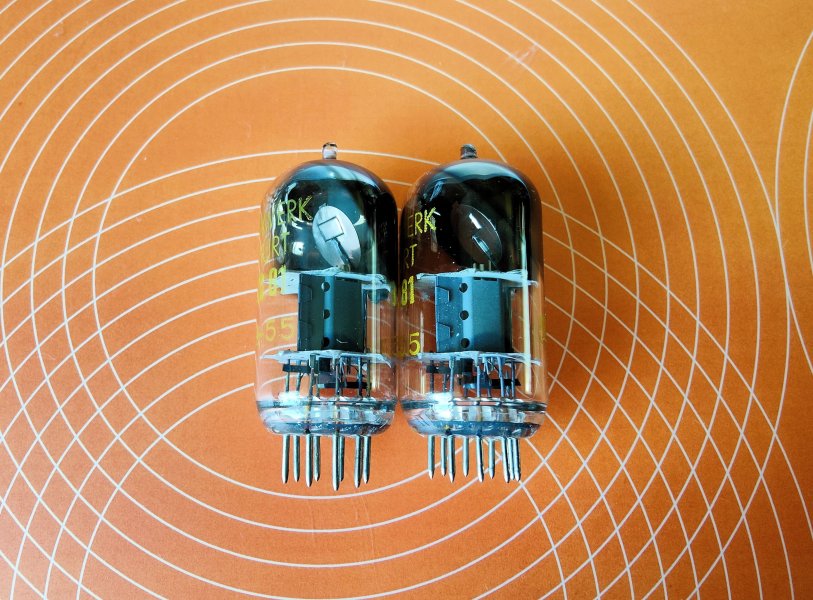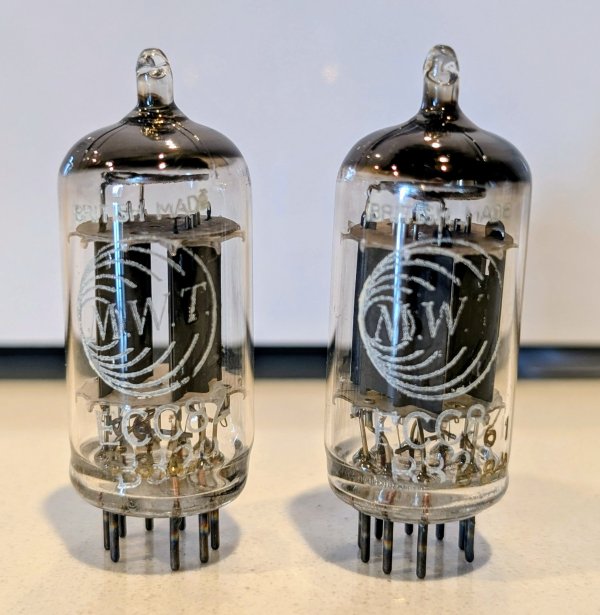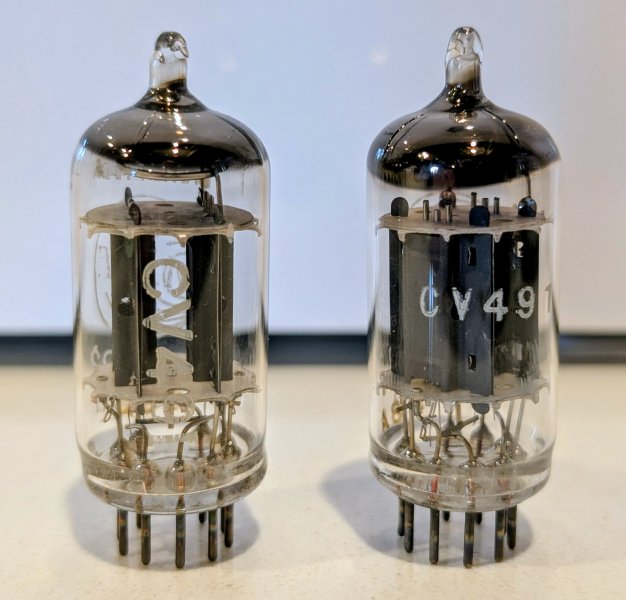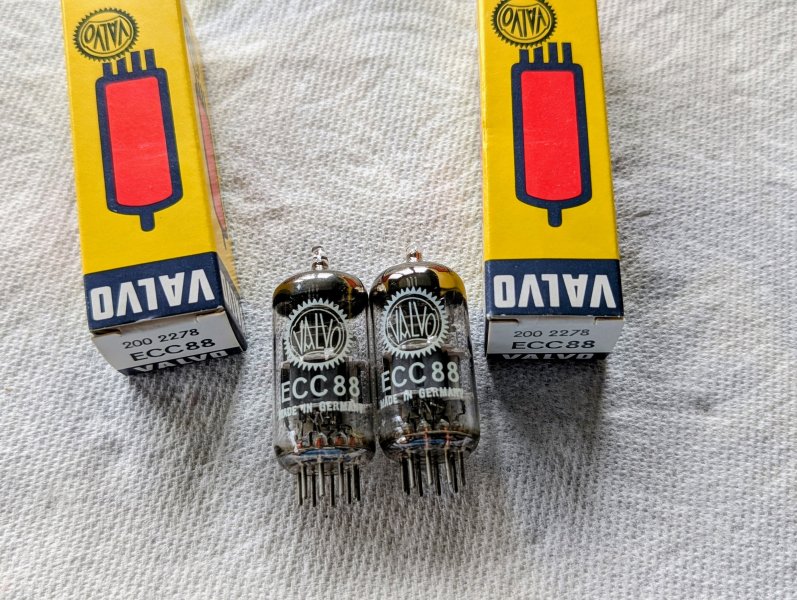My Tube Collection, Welcome to share yours
- Thread starter adrian cheng
- Start date
You are using an out of date browser. It may not display this or other websites correctly.
You should upgrade or use an alternative browser.
You should upgrade or use an alternative browser.
I could be wrong but I think that's an AEG WF Oberspree? I've been reading about them a bit. Do you like the sound of it?RFT ECC81 rebranded as Ultron (at least this is what I know). The shape of glass is a little bit strange, not quite rounded on top.
View attachment 158148
My phone will also enhance or stylize the photos.Thank you very much for the excellent advice and I'll definitely be trying out the suggestions soon. I've been remodeling the house lately so I'm starting to become a little cleaner, more organized and just trying to improve things overall.
From this:

It made this black & white version:
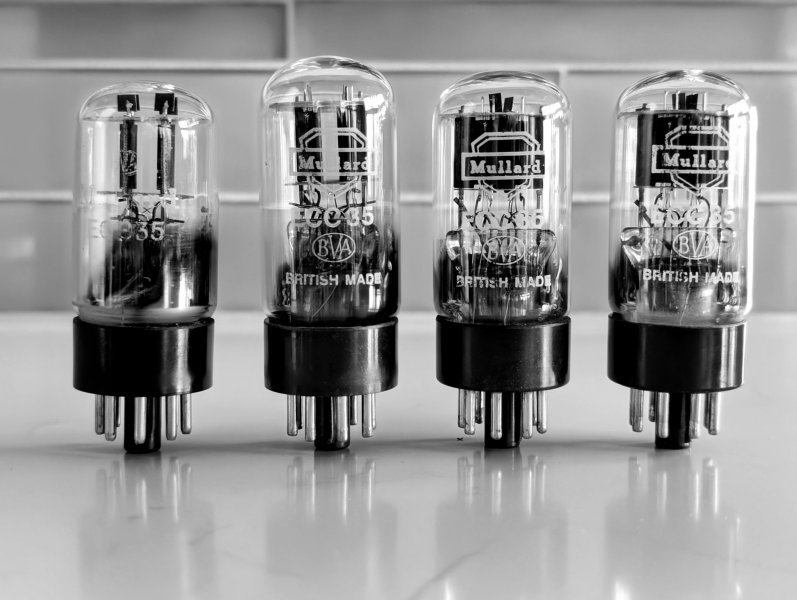
I always thought those "WF" tubes are RFT. I never tried it, maybe one day. Seems an interesting tube for people into ECC81.I could be wrong but I think that's an AEG WF Oberspree? I've been reading about them a bit. Do you like the sound of it?
I always thought those "WF" tubes are RFT. I never tried it, maybe one day. Seems an interesting tube for people into ECC81.

Werk für Fernsehelektronik – Wikipedia
Company history
Prehistory
Around 1900, numerous companies settled in Berlin-Oberschöneweide, including AEG. From 1913, the production of electron tubes began at the AEG cable factory in Oberspree. From the 1930s onwards, Telefunken produced transmitters in Oberschöneweide. In 1938, AEG's tube production was combined in the AEG tube factory in Oberspree. The company took possession of the building built in 1917 for the National Automobile Company as a production facility.Development in the Soviet Occupation Zone/GDR
 Production of transmitter tubes (1970)
Production of transmitter tubes (1970) Testing of Germanium Tip Diodes (1971)
Testing of Germanium Tip Diodes (1971)In 1945, the Soviet military administration in Germany founded the Laboratory, Design Office and Experimental Plant Oberspree (LKVO) as a scientific industrial enterprise in the rooms of the former AEG tube factory. After just one year, this company had over 2,000 employees. In 1946, 230 employees and their families were taken to the Soviet Union to set up a corresponding production line there. In 1946, the company was converted into a Soviet Joint Stock Company (SAG) and was now called Oberspreewerk (OSW). In 1950, the company merged with other companies and was renamed Werk für Telemeldewesen. On 1 May 1952, the Oberspreewerk became a state-owned enterprise (VEB). The production of germanium tip diodes began in 1957.[1] In connection with the emergence of German television and the television sets needed for the population, a Japanese plant for the production of black-and-white picture tubes was put into operation in the factory halls in 1959. [2]
In 1960, the company was renamed Werk für Fernsehelektronik. [1] When large combines were formed in the 1970s, the WF was assigned to the Erfurt Microelectronics Combine. In 1983, the production of black-and-white picture tubes was discontinued, and in 1984 the production of color picture tubes began, for which a new production plant had been built on Ostendstraße with the help of the Japanese manufacturer Toshiba.
I'm not 100% sure what to think because it's so complicated and I guess it depends on the date of the tube. There's some sort of communist relationship between a lot of companies on the Eastern side after WWII. The only thing I'm fairly certain of is that tube was manufactured in Oberschöneweide in that factory.
It is indeed very interesting. Thank you for letting me know about this.I'm not 100% sure what to think because it's so complicated and I guess it depends on the date of the tube. There's some sort of communist relationship between a lot of companies on the Eastern side after WWII. The only thing I'm fairly certain of is that tube was manufactured in Oberschöneweide in that factory.
The confusion between WF and RFT arises because a certain stockpile of tubes emanating from both these factories, the former AEG factory in Oberspree and the former Telefunken factory at Mulhausen, got RFT branding at a later date. In fact, HF (and later WF) tubes are Oberspree and RFT are Mulhausen. The small signal tubes like the ECC81s pictured above are most probably RFT made.
Werk für Fernsehelektronik – Wikipedia
de.wikipedia.org
Company history
Prehistory
Around 1900, numerous companies settled in Berlin-Oberschöneweide, including AEG. From 1913, the production of electron tubes began at the AEG cable factory in Oberspree. From the 1930s onwards, Telefunken produced transmitters in Oberschöneweide. In 1938, AEG's tube production was combined in the AEG tube factory in Oberspree. The company took possession of the building built in 1917 for the National Automobile Company as a production facility.
Development in the Soviet Occupation Zone/GDR
Production of transmitter tubes (1970)
Testing of Germanium Tip Diodes (1971)
In 1945, the Soviet military administration in Germany founded the Laboratory, Design Office and Experimental Plant Oberspree (LKVO) as a scientific industrial enterprise in the rooms of the former AEG tube factory. After just one year, this company had over 2,000 employees. In 1946, 230 employees and their families were taken to the Soviet Union to set up a corresponding production line there. In 1946, the company was converted into a Soviet Joint Stock Company (SAG) and was now called Oberspreewerk (OSW). In 1950, the company merged with other companies and was renamed Werk für Telemeldewesen. On 1 May 1952, the Oberspreewerk became a state-owned enterprise (VEB). The production of germanium tip diodes began in 1957.[1] In connection with the emergence of German television and the television sets needed for the population, a Japanese plant for the production of black-and-white picture tubes was put into operation in the factory halls in 1959. [2]
In 1960, the company was renamed Werk für Fernsehelektronik. [1] When large combines were formed in the 1970s, the WF was assigned to the Erfurt Microelectronics Combine. In 1983, the production of black-and-white picture tubes was discontinued, and in 1984 the production of color picture tubes began, for which a new production plant had been built on Ostendstraße with the help of the Japanese manufacturer Toshiba.
I'm not 100% sure what to think because it's so complicated and I guess it depends on the date of the tube. There's some sort of communist relationship between a lot of companies on the Eastern side after WWII. The only thing I'm fairly certain of is that tube was manufactured in Oberschöneweide in that factory.
Might be not as Mr.Miniwatt's ecc81 was made in the 1960s, these earlier one might be
Werk für Fernsehelektronik – Wikipedia
de.wikipedia.org
Company history
Prehistory
Around 1900, numerous companies settled in Berlin-Oberschöneweide, including AEG. From 1913, the production of electron tubes began at the AEG cable factory in Oberspree. From the 1930s onwards, Telefunken produced transmitters in Oberschöneweide. In 1938, AEG's tube production was combined in the AEG tube factory in Oberspree. The company took possession of the building built in 1917 for the National Automobile Company as a production facility.
Development in the Soviet Occupation Zone/GDR
Production of transmitter tubes (1970)
Testing of Germanium Tip Diodes (1971)
In 1945, the Soviet military administration in Germany founded the Laboratory, Design Office and Experimental Plant Oberspree (LKVO) as a scientific industrial enterprise in the rooms of the former AEG tube factory. After just one year, this company had over 2,000 employees. In 1946, 230 employees and their families were taken to the Soviet Union to set up a corresponding production line there. In 1946, the company was converted into a Soviet Joint Stock Company (SAG) and was now called Oberspreewerk (OSW). In 1950, the company merged with other companies and was renamed Werk für Telemeldewesen. On 1 May 1952, the Oberspreewerk became a state-owned enterprise (VEB). The production of germanium tip diodes began in 1957.[1] In connection with the emergence of German television and the television sets needed for the population, a Japanese plant for the production of black-and-white picture tubes was put into operation in the factory halls in 1959. [2]
In 1960, the company was renamed Werk für Fernsehelektronik. [1] When large combines were formed in the 1970s, the WF was assigned to the Erfurt Microelectronics Combine. In 1983, the production of black-and-white picture tubes was discontinued, and in 1984 the production of color picture tubes began, for which a new production plant had been built on Ostendstraße with the help of the Japanese manufacturer Toshiba.
I'm not 100% sure what to think because it's so complicated and I guess it depends on the date of the tube. There's some sort of communist relationship between a lot of companies on the Eastern side after WWII. The only thing I'm fairly certain of is that tube was manufactured in Oberschöneweide in that factory.
Attachments
The confusion between WF and RFT arises because a certain stockpile of tubes emanating from both these factories, the former AEG factory in Oberspree and the former Telefunken factory at Mulhausen, got RFT branding at a later date. In fact, HF (and later WF) tubes are Oberspree and RFT are Mulhausen. The small signal tubes like the ECC81s pictured above are most probably RFT made.
Thank you very much for the information. It makes a lot of sense why these tubes have branding like that now. I just started learning about these tubes and ordered some ECC81/ECC82 but haven't heard them yet.
I don't know the relationship between all these companies but It seems to center around WWII and there's definitely a communist connection from what I understand. The East German companies and even others like Polam look a lot alike. When you read that they moved people and equipment around it makes a lot of sense.
I notice the folded plates right away and it makes me think there's a connection. Do you like the sound of that tube?Might be not as Mr.Miniwatt's ecc81 was made in the 1960s, these earlier one might be
Yes, exactly. After WWII, all the former privately owned factories and businesses went under Soviet control. A lot changed but some of the manufacturing know-how, quality control standards and last but not least human scientific ingenuity prevailed...Thank you very much for the information. It makes a lot of sense why these tubes have branding like that now. I just started learning about these tubes and ordered some ECC81/ECC82 but haven't heard them yet.
I don't know the relationship between all these companies but It seems to center around WWII and there's definitely a communist connection from what I understand. The East German companies and even others like Polam look a lot alike. When you read that they moved people and equipment around it makes a lot of sense.
Yes, quite like themI notice the folded plates right away and it makes me think there's a connection. Do you like the sound of that tube?
Speaking about these tubes with bigger glass, I also have an ECC83/12AX7:
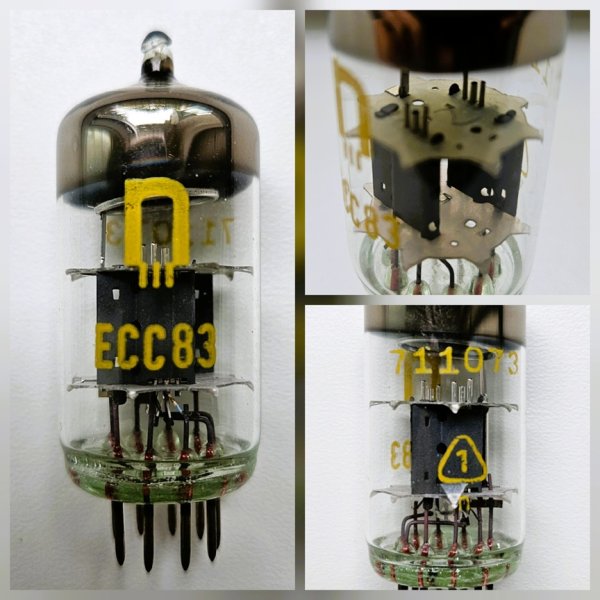
This one has a bigger glass than other 12AX7, similar somehow with that 12AT7 we spoke before. This one is an RFT, that "1" inside a triangle is a quality mark specific for RFT.
If you look at both, they share some common construction elements:
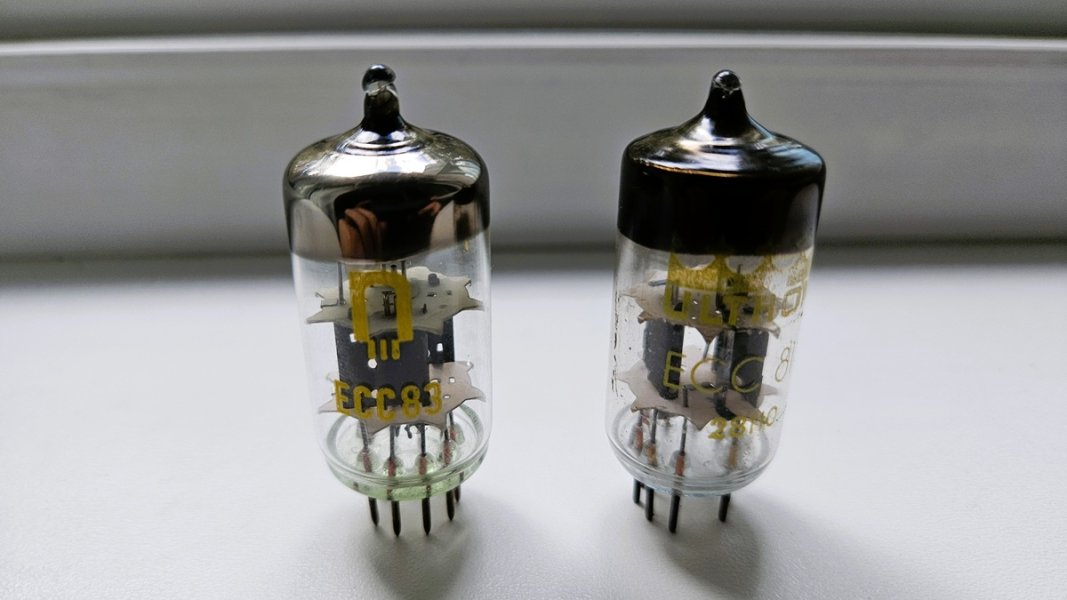

This one has a bigger glass than other 12AX7, similar somehow with that 12AT7 we spoke before. This one is an RFT, that "1" inside a triangle is a quality mark specific for RFT.
If you look at both, they share some common construction elements:

Last edited:
From reading around the internet it seems like there's four relavant RFT audio tube factories. I think I have 3 of them in ECC83.
VEB Werk für Fernmeldewesen Berlin-Oberschöneweide, Ostendstrasse 1-5, East Germany (= WF)
Muhlhausen, or VEB Röhrenwerk Mühlhausen, Thüringen, Eisenacher Strasse 40, East Germany (= M) (RWM)
Neuhaus, or VEB Röhrenwerk "Anna Seghers" Neuhaus am Rennweg, East Germany (= RWN) (Röhrenwerk Anna Seghers)
VEB Funkwerk Erfurt, East Germany (= W)
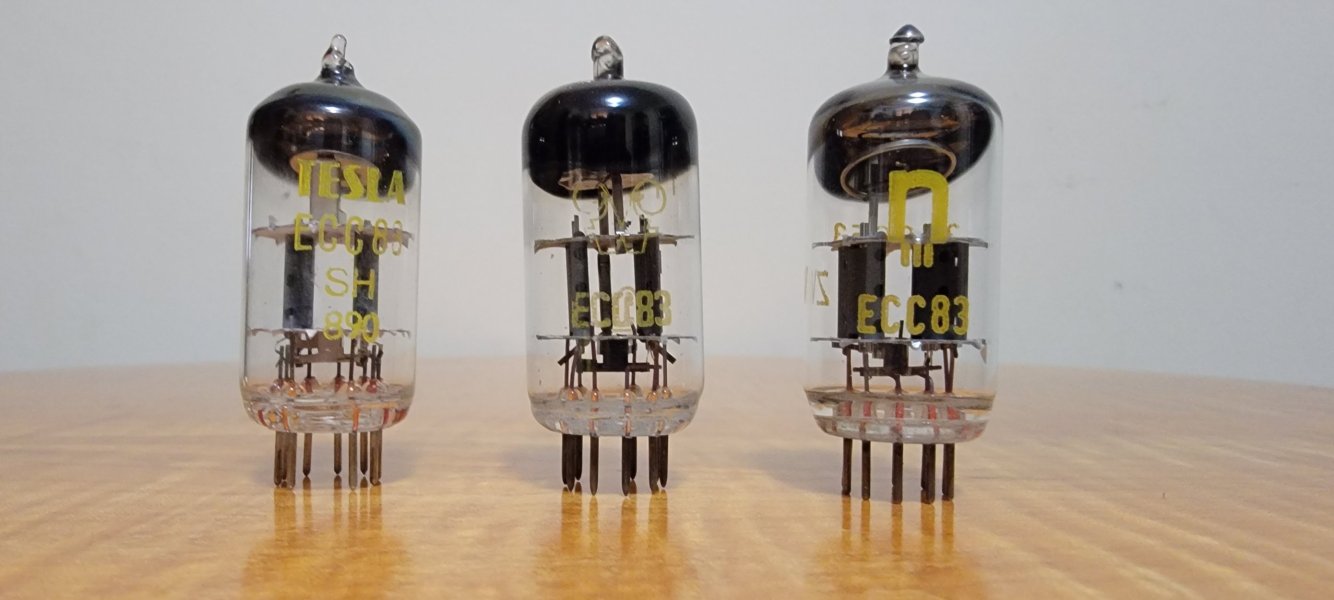
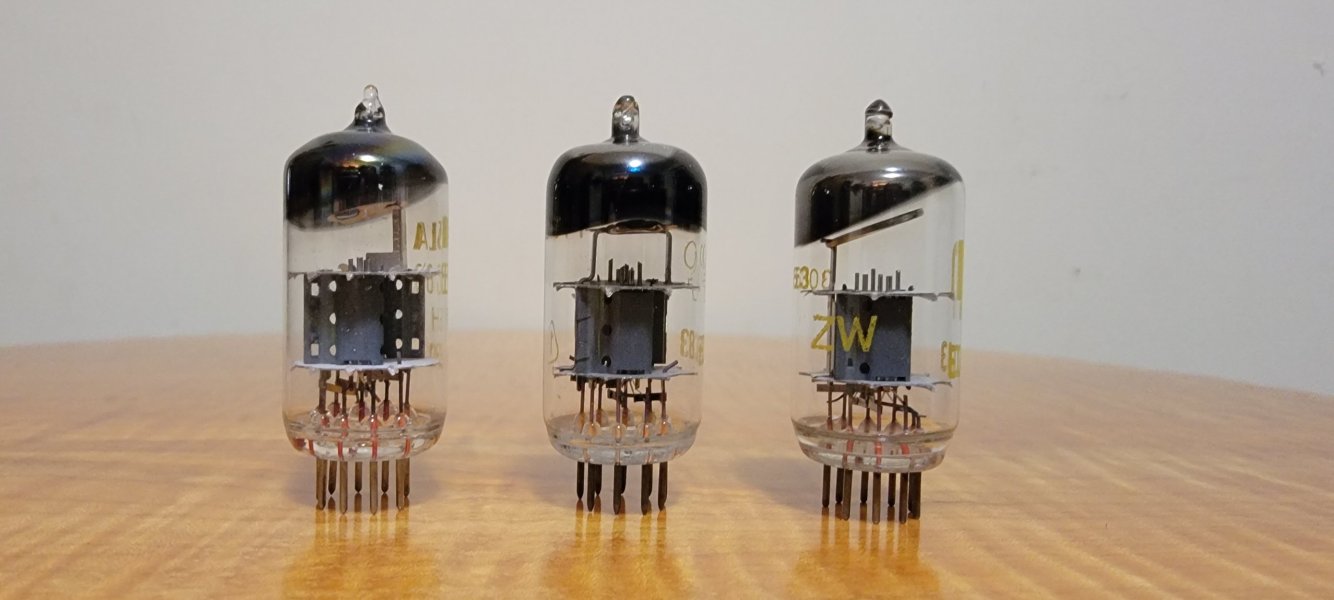
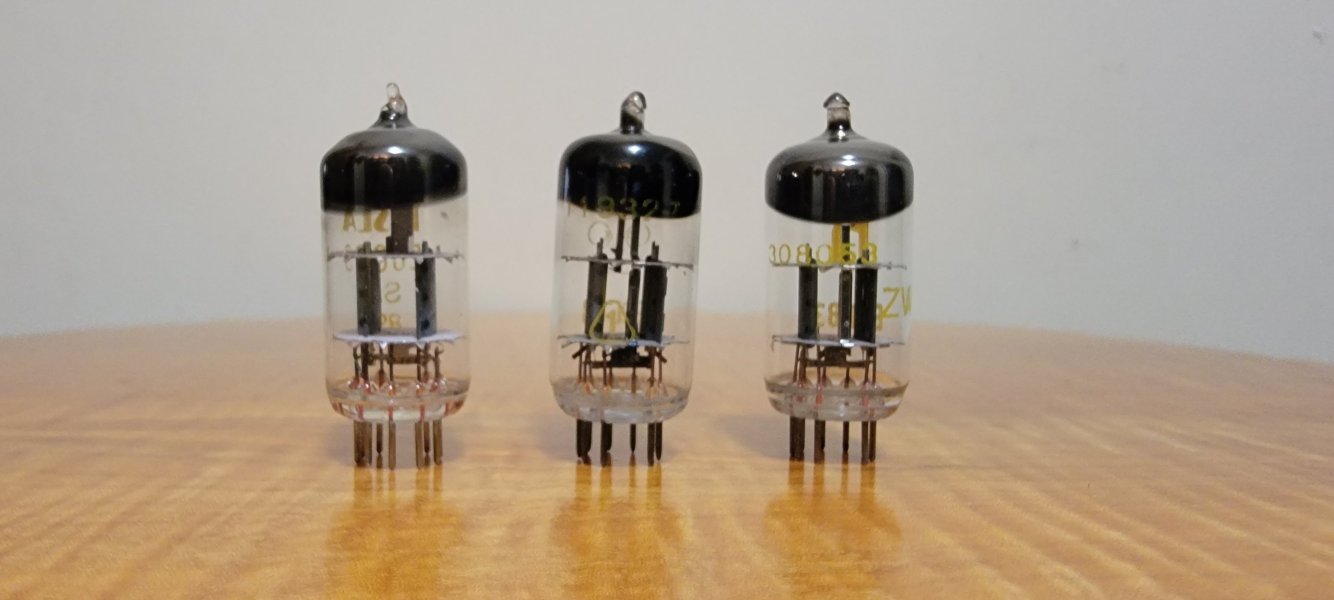
VEB Werk für Fernmeldewesen Berlin-Oberschöneweide, Ostendstrasse 1-5, East Germany (= WF)
Muhlhausen, or VEB Röhrenwerk Mühlhausen, Thüringen, Eisenacher Strasse 40, East Germany (= M) (RWM)
Neuhaus, or VEB Röhrenwerk "Anna Seghers" Neuhaus am Rennweg, East Germany (= RWN) (Röhrenwerk Anna Seghers)
VEB Funkwerk Erfurt, East Germany (= W)



Wow! Great photos. Well done.From reading around the internet it seems like there's four relavant RFT audio tube factories. I think I have 3 of them in ECC83.
VEB Werk für Fernmeldewesen Berlin-Oberschöneweide, Ostendstrasse 1-5, East Germany (= WF)
Muhlhausen, or VEB Röhrenwerk Mühlhausen, Thüringen, Eisenacher Strasse 40, East Germany (= M) (RWM)
Neuhaus, or VEB Röhrenwerk "Anna Seghers" Neuhaus am Rennweg, East Germany (= RWN) (Röhrenwerk Anna Seghers)
VEB Funkwerk Erfurt, East Germany (= W)
View attachment 158200View attachment 158201View attachment 158203
Thank you! I'm going to work on things like you suggested and try to improve my photography. Baby steps.Wow! Great photos. Well done.
Similar threads
- Replies
- 192
- Views
- 11K
- Replies
- 8
- Views
- 2K
- Replies
- 4
- Views
- 113
- Replies
- 4
- Views
- 2K
- Replies
- 71
- Views
- 11K
| Steve Williams Site Founder | Site Owner | Administrator | Ron Resnick Site Owner | Administrator | Julian (The Fixer) Website Build | Marketing Managersing |






